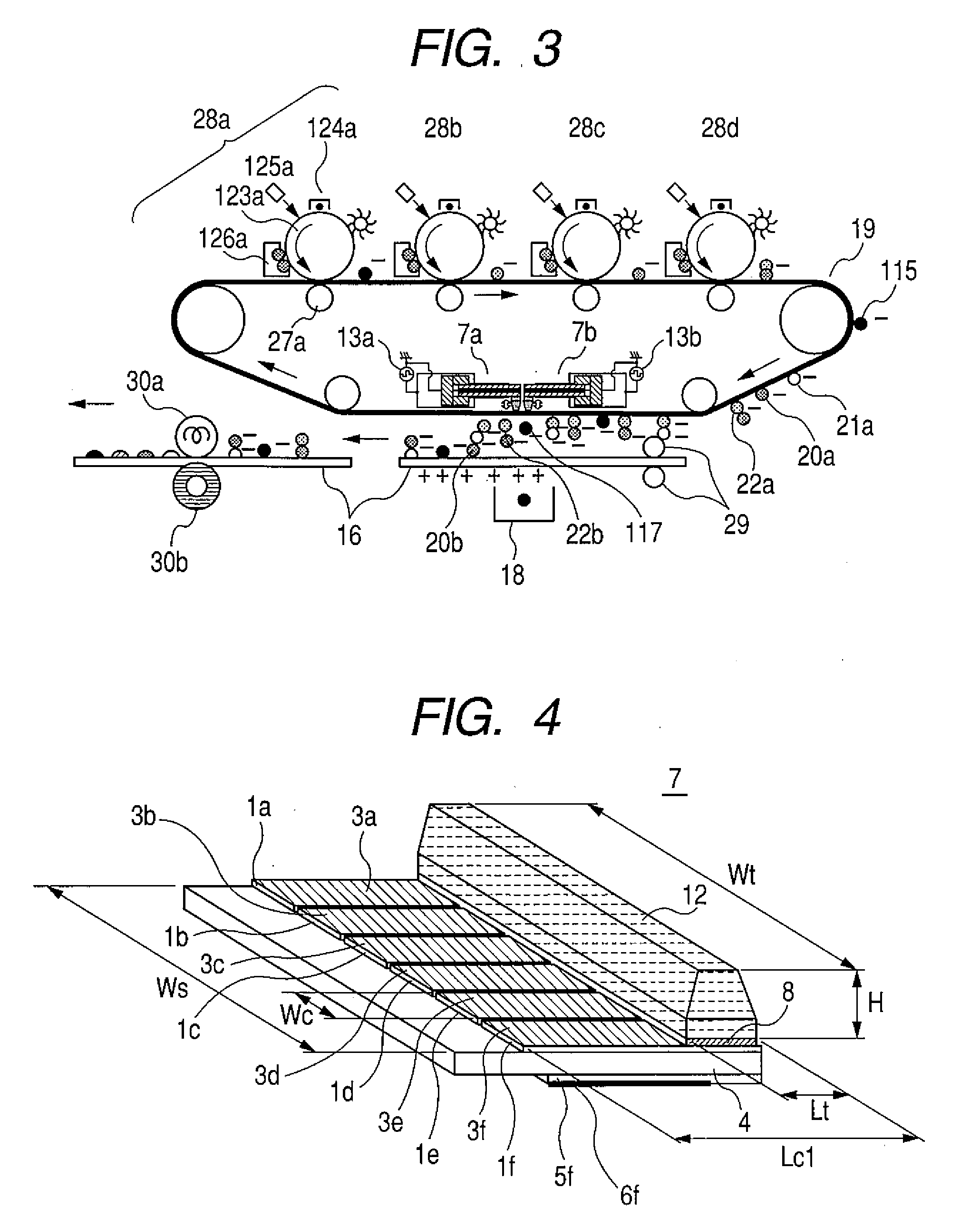Transfer apparatus, method of manufacturing the transfer apparatus and image forming apparatus using the transfer apparatus
a technology of transfer apparatus and manufacturing method, which is applied in the direction of piezoelectric/electrostrictive/magnetostrictive devices, electrographic process apparatus, instruments, etc., can solve the problems of high cost, mutual interference preventing individual resonators from having uniform vibration characteristics, and inability to supply vibration energy to the toner image supporting body between the adjacent horns. , to achieve the effect of superior toner transfer and high cos
- Summary
- Abstract
- Description
- Claims
- Application Information
AI Technical Summary
Benefits of technology
Problems solved by technology
Method used
Image
Examples
first embodiment
[0115]FIG. 1 illustrates the structure of a transfer apparatus in a first embodiment of the present invention, in which a toner image made of toner 115, 117 and formed on the OPC photosensitive belt 19 is transferred to roughened surface paper or a second surface used in double-sided printing. The paper 16 includes a void 17 with a depth of 20 to 30 μm and a width of 50 to 100 μm on the surface. The toner 115, 117 is negatively charged; its particle is 9 μm in diameter. The transfer apparatus is a continuous paper printer with a process speed (vector movement speed) of 23 ips; it adapts to paper 16 with a width of 20.5 inches, the printing width being 19.5 inches. The vibrating unit is formed by changing the piezoelectric bimorph element 7 illustrated in FIG. 5 to the cantilever structure illustrated in FIGS. 8(a) and 8(b). During non-driving, the protrusion portion 12 is apart from the backside of the belt 11. The shim member 4 of the piezoelectric bimorph element 7 is a stainless ...
second embodiment
[0117]FIG. 2 is a structural diagram illustrating the transfer apparatus according to the second embodiment of the present invention. The drawing shows the structure of the apparatus that transfers a color toner image to the front surface of an embossed paper 16, the color toner image being formed on the intermediate transfer belt 19 made of polyimide resin by overlapping toners 20a, 21a, 22a and 115 in four colors, yellow (Y), magenta (M), cyan (C), and black (K). Many voids 17 in various shapes are formed on the surface of the embossed paper 16. Accordingly, to have each toner 20a, 21a, 22a and 115 comprising a plurality of layers fly from the intermediate transfer belt 19 and transfer to the surface of a void, a great inertia force must be applied to the toner 20a, 21a, 22a and 115. The toner 20a, 21a, 22a and 115 is a negatively charged toner with a particle diameter of 9 μm. The printer is a continuous paper printer with a print density of 600 dpi and a process speed (vector mo...
third embodiment
[0118]FIG. 3 is a structural diagram illustrating an image forming apparatus in which the transfer apparatus in the present invention is used. The K toner image forming part 28a, C toner image forming part 28b, M toner image forming part 28c, and Y toner image forming part 28d have basically the same structure except that they use different developers. Therefore, only the structure of the K toner image forming part 28a will be described below. The OPC photosensitive drum 123a is charged by the charger 124a, after which an electrostatic latent image corresponding to a print image is formed by the exposing part 125a. The developing unit 126a then forms a K toner image on the photosensitive drum. The toner 20a, 21a, 22a or 115 is negatively charged, so the toner image is transferred to the intermediate transfer belt 19 by the transfer roll 30a to which a positive voltage has been applied. A C toner image, M toner image, and Y toner image are transferred to the rotating intermediate tra...
PUM
 Login to View More
Login to View More Abstract
Description
Claims
Application Information
 Login to View More
Login to View More - R&D
- Intellectual Property
- Life Sciences
- Materials
- Tech Scout
- Unparalleled Data Quality
- Higher Quality Content
- 60% Fewer Hallucinations
Browse by: Latest US Patents, China's latest patents, Technical Efficacy Thesaurus, Application Domain, Technology Topic, Popular Technical Reports.
© 2025 PatSnap. All rights reserved.Legal|Privacy policy|Modern Slavery Act Transparency Statement|Sitemap|About US| Contact US: help@patsnap.com



